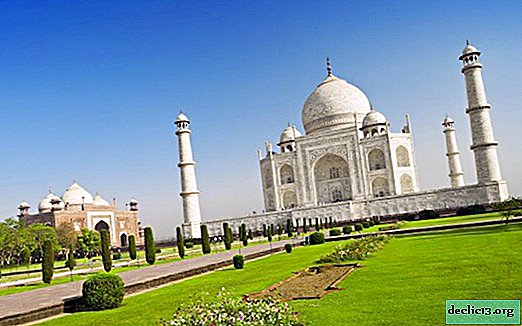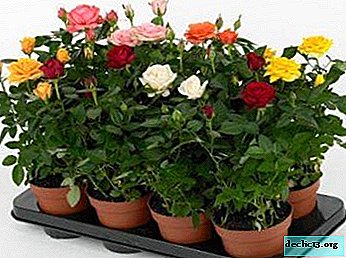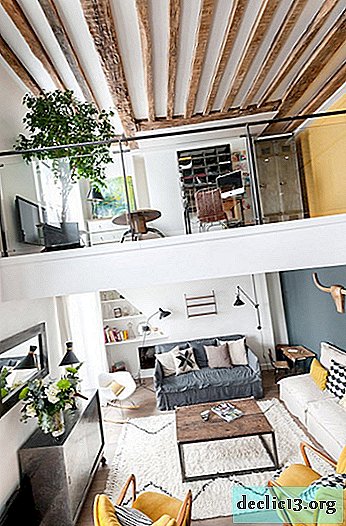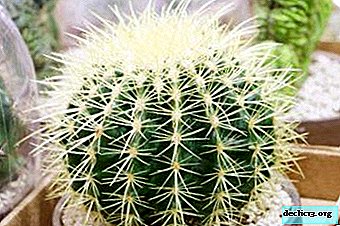Taj Mahal in India - Marble Song of Love
Taj Mahal (India) - the most famous landmark of the country, located in Agra, on the banks of the Jamna River. The Taj Mahal is an incomparable beauty ensemble consisting of a palace-mausoleum, a mosque, the main gate, a guest house and a landscape park with an irrigation system. This complex was built by Padishah Shah Jahan as the last tribute to his beloved wife Mumtaz Mahal.

Interesting! The Taj Mahal can be seen in many films, for example: "Life after the people", "Armageddon", "Slumdog Millionaire", "Has not yet played in the box."
This article briefly describes the history of the creation of the Taj Mahal, there is also a lot of useful information for people who are going to visit this landmark of India. Here are colorful pictures of the Taj Mahal taken outside and inside the building.
A bit of history
It can be argued that, to some extent, the history of the creation of the Taj Mahal dates back to 1612. It was then that the Mughals of the Mughal Empire, Shah Jahan married Arjumand Bano Begum. In history, this woman is better known as the Mumtaz Mahal, which means "Decoration of the Palace." Shah Jahan loved his wife very much, he trusted and consulted with her about everything. Mumtaz-Mahal accompanied the ruler in military campaigns, was present at all events at the state level, and if she could not attend any event, then he was simply postponed.
The story of love and a happy family life of a noble couple lasted 18 years. During this time, Mumtaz-Mahal gave her husband 13 children, but she could not survive the birth of the 14th child.
After the death of his wife, Shah Jahan spent a whole year in seclusion, aged and hunched over that time. To pay the last tribute of love to Mumtaz Mahal, the padishah decided to erect a palace-mausoleum, which was not and will not be equal on Earth.

A fact from history! A total of over 22,000 artisans from the Mughal Empire, Persia, Central Asia and the Middle East participated in the creation of the complex.
As is known from history, the Taj Mahal began to be built at the end of 1631. For this, a 1.2 hectare site was selected, located outside Agra, near the Jamna River. The site was completely dug up, soil was replaced to reduce infiltration, and the site was raised 50 meters above the riverbank.
Interesting! Usually, bamboo forests were used during construction in India, and brick forests were erected around the tomb. Since they were too large-scale and durable, the craftsmen who supervised the work worried that it would take more than one year to disassemble them. But Shah Jahan ordered to announce that everyone can take any number of bricks - as a result, literally overnight, the entire auxiliary building was dismantled.
Since the construction was carried out in stages, there are different opinions as to what constitutes the completion of the Taj Mahal. The platform and the central mausoleum (including work inside the building) were completed by 1943, and work on the creation of all other elements of the complex lasted another 10 years.

A fact from history! Building and decoration materials were brought in from almost all over the world: white marble - from the lands of Rajasthan, jasper - from Punjab, jade - from China, carneol - from Arabia, chrysolite - from the Nile coast, sapphire - from Ceylon, carnelian - from Baghdad, rubies - from the kingdom of Siam, turquoise - from Tibet.
Shah Jahan left many architectural sights to the descendants, but it was the Taj Mahal that remained in history as an unsurpassed monument that forever immortalized the names of the padishah and his faithful companion.
In 1666, Shah Jahan died, he was buried inside the Taj Mahal, near Mumtaz Mahal.
But the story of the Taj Mahal in India did not end with the death of its creator.
PresentNot so long ago, cracks were revealed on the walls of the Taj Mahal. Scientists believe that their education is directly related to the drying up of the Jamna River, which flows nearby. The drying up of the river channel leads to the fact that the structure of the soil changes and, as a result, the building shrinks.

Due to the polluted air in this area of India, the Taj Mahal is losing its whiteness - this is also visible in the photo. And even the expansion of the green zone around the complex and the closure of several of Agra's most dirty production facilities do not help: the building turns yellow. In order to somehow maintain the legendary whiteness of marble walls, they are regularly cleaned with white clay.
But, despite all this, the magnificent Taj Mahal (Agra, India) invariably attracts with its architectural perfection and the legend of true love.
Interesting fact! From 3,000,000 to 5,000,000 tourists visit this attraction annually, of which more than 200,000 are foreigners.
Complex architecture
The architecture of the Taj Mahal harmoniously combines elements of several styles: Indian, Persian, Arabic. A brief description and colorful photographs will help you understand the beauty of the Taj Mahal.
The Taj Mahal is an ensemble consisting of a central gate, a garden, a mosque, a guest pavilion and a mausoleum palace, inside which are the tombs of Mumtaz Mahal and Shah Jahan. The territory fenced from 3 sides, on which the complex is equipped, has a rectangular shape (sizes 600 and 300 meters). The main gate, made of red stone, resembles a small palace with side towers. These towers are crowned with domes, and above the entrance in 2 rows of 11 pieces are small domed umbrellas. There are phrases from the Qur'an at the entrance gate that end with the words "Enter My Paradise!" - Shah Jahan created a paradise for his beloved.

An integral part of the ensemble, which emphasizes the color and texture of the tomb, is Char-Bagh (4 gardens). In the center of the road, laid from the gate to the mausoleum, there is a canal, in the waters of which this snow-white marble building is reflected.
On the west side of the mausoleum is a mosque of red sandstone, to the east - a guest house. Its main task was only to maintain the symmetry of the entire architectural complex.
MausoleumAs can be seen in the photo, the Taj Mahal stands on a marble platform, with its back side it is turned to the river Jamna. The platform has a square shape, each side reaches a length of 95.4 meters. At the corners of the platform are beautiful snow-white minarets, looking up (their height is 41 meters). The minarets lean slightly in opposite directions from the tomb - as chroniclers wrote in history, this was done so that during an earthquake they would not crash into the building and destroy everything inside it.
The Taj Mahal, erected from blocks of snow-white marble, rises up to 74 meters. Crowned with the construction of 5 domes: a central onion-shaped dome (diameter 22.5 meters) surrounded by 4 smaller domes.

Interesting fact! Due to the peculiarities of polished marble, the Taj Mahal changes color several times a day: at sunrise it appears pink, in the daytime it shines with white, in the evening twilight it emits a lilac-pink glow, and with the moon it looks silvery.
An intricate pietra dura pattern is carved on the walls of the Taj Mahal and inlaid with gems. In total, 28 types of stones were used for inlaying. Looking at the fine details, you can appreciate the complexity of the work that the craftsmen had to do: for example, there are small decorative elements (3 cm²), on which more than 50 gem stones are placed. On the walls around the arched openings, sayings from the Koran are carved.

Interesting! The lines with phrases from the Koran look the same regardless of how high they are from the floor. Such an optical effect is created as follows: the higher the line is located, the larger the font is used and the greater the gap between the letters.
How the mausoleum looks inside
After splendor and airiness - and this is how I want to describe the impressions of the appearance of the Taj Mahal - from the inside, it does not seem so impressive. But this is only at first glance.
Inside, along the walls of the tomb, passes a corridor, at the corners of which octagonal chambers are arranged. Under the main dome, closed inside the corridor surrounding it, is the main hall.

Inside the mausoleum, in the main hall, the tombs of Mumtaz-Mahal and Shah-Jahan are installed. Around them stands an exquisite fence: marble slabs with carved patterns, decorated with hammered gold and precious gems.
It should be noted that inside the Taj Mahal is also symmetrical, as well as outside. Only the cenotaph of Shah Jahan, established much later than the cenotaph of Mumtuz-Mazal, violates this symmetry. The tomb of Mumtuz-Mazal, which was installed inside the tomb immediately when it was created, stands in the very center, right under the central dome.
The real burial places of Mumtaz Mahal and Shah Jahan are inside the crypt, strictly under the tombs.

Taj Museum
Inside the memorial ensemble, in the western part of the park, there is a small but quite interesting museum. It works from 10:00 to 17:00, admission is free.
Among the exhibits displayed inside the museum:
- architectural drawings of the palace-mausoleum;
- coins made of silver and gold, which were in use during the time of Shah Jahan;
- originals of miniatures with portrait images of Shah Jahan and Mumtaz Mahal;
- dishes from celadon (there is an interesting story that these plates will fly apart or change color if they contain poisoned food).
Practical information

- Attraction address: Dharmaperi, Forest Coloni, Tagging, Agra, Uttar Pradesh 282001, India.
- Official site of this historical monument: //www.tajmahal.gov.in.
- The Taj Mahal opens 30 minutes before sunrise and stops receiving visitors 30 minutes before sunset. This schedule is relevant for any day of the week except Friday. On Fridays, only those who want to attend a service in the mosque are allowed in the complex.
Tickets: where to buy and price
- For tourists who come to India from other countries, a ticket to enter the site of the attraction costs 1100 rupees (approximately $ 15.5).
- To see the tomb inside, you need to pay another 200 rupees (about $ 2.8)
- Children under the age of 15 can watch for free the entire territory and the atmosphere inside the mausoleum.
You can buy tickets at the box office, which are located at the East and West Gate. Ticket offices open 1 hour before sunrise and stop working 45 minutes before sunset. Separate windows are provided at the box office for foreigners and Indian citizens.

It is possible to purchase tickets online. Sales services are offered by only one official website - this is the website of the Ministry of Culture of India: //asi.payumoney.com. Booking electronic tickets on this portal is available to both citizens of India and foreign tourists. Moreover, foreigners at the same time receive a discount of 50 rupees (approximately $ 0.7).
The ticket price includes a bottle of water and shoe covers - at the entrance they are issued to all visitors. Shoe covers made of a nice soft fabric should be worn over the shoes.
Prices and timetables on the page are for September 2019.
Useful Tips
- All ticket offices have separate windows for Indian citizens and foreign tourists (here they are usually much smaller) - you just need to look at the signs. On the way to the box office, local traders usually pester foreigners, offering tickets at very high prices (2-3 times more expensive). The most convenient option to save time and save nerves is to make a reservation on the website of the Ministry of Culture of India.
- The local government of Agra is doing everything possible to prevent terrorist acts and in order to protect historical monuments from acts of vandalism. To do this, at the entrance to the complex there are special points for screening visitors. Inside the complex you can carry only a bottle of water, a camera without a tripod, money, documents and a map of the Agra travel guide. Everything else must be taken to the storage room. Therefore, you should not take large bags with you: this will only increase the time of inspection, and you will still have to stand in line for the left-luggage offices.
- Inspection points for foreigners and for the Indian population are separate - you need to carefully look at what queue to become. Examination of women and men is also carried out separately, respectively, and the lines are different.
- There is a free Wi-Fi zone within a radius of about 50 meters from the security checkpoint.
- The Taj Mahal (India) is especially magnificent at dawn, so the time from 5:30 is considered the best to visit. In addition, at this time there are much fewer people here, and you can safely see everything inside the building.
- No photographs can be taken inside the Taj Mahal mausoleum, but no one forbids this on the territory adjacent to it. Impressive shots are taken at dawn, when the palace is wrapped in a morning haze and as if floating in the air. And how cute and naive the frames are, in which visitors hold the palace at the top of the dome!
- The right time of year to visit the Taj Mahal is the key to the most positive impressions and emotions. The ideal time to travel to Agra is February and March. From April to July, suffocating heat is kept here, the temperature rises to + 45 ° С. In July, the rainy season begins, and it ends only in September. From October to almost February there are heavy fogs in the city, due to which the Taj Mahal is barely visible.


Taj Mahal - the eighth wonder of the world:

















